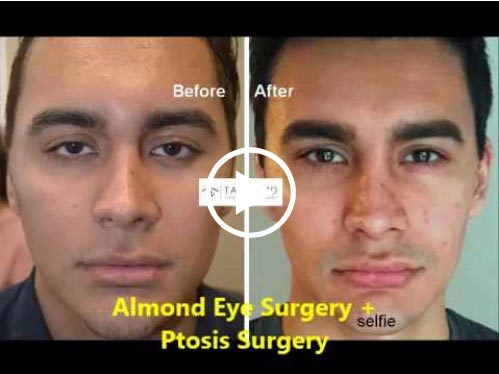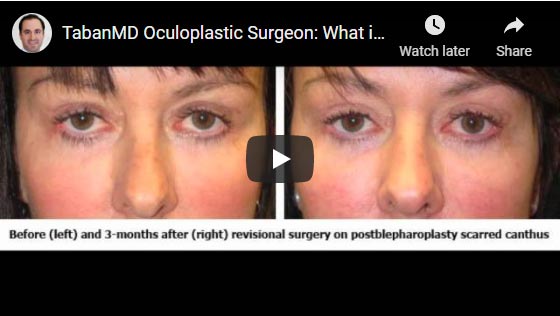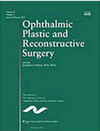Canthoplasty
Canthoplasty is as aesthetic or functional procedure to reconstruct or reshape the lateral canthus (outer corner of the eye). This oculoplastic surgery should only be performed by surgeons with significant experience with oculoplastic surgery. If performed incorrectly the results can be disastrous. “Canthopexy” is different than canthoplasty. Canthopexy merely reinforces the canthus without cutting; thereby it does not alter the horizontal length of the eyelid and it does not alter the position of canthus.


What Is Canthoplasty Surgery?
Canthoplasty can tighten a saggy, loose lower eyelid. It can also reshape and reposition the lateral canthus. This is especially useful in those patients who have had prior complicated lower eyelid surgery (blepharoplasty) with retracted (pulled down) lower eyelid and rounded canthus and unpleasant “surgical” appearance, who need revisional eyelid surgery. It also treats lower eyelid laxity (ectropion), where the lower eyelid is floppy. Dr Taban uses a minimally invasive approach for canthoplasty and tightening the lower eyelid, which provides better eyelid contour with hidden scars, entitled “Aesthetic Lateral Canthoplasty”.
Canthoplasty may be combined with other eyelid and periocular surgeries, if necessary, such as blepharoplasty, ptosis surgery, brow lift, and midface lift. The surgery is usually done under local anesthesia, with or without intravenous sedation. The recovery usually involves 7-10 of swelling/bruising.
Who Should Perform The Surgery?
When choosing a plastic surgeon to perform canthoplasty, look for an oculoplastic surgeon, with membership in the American Society of Ophthalmic Plastic and Reconstructive Surgery (ASOPRS), which indicates he or she is not only a board certified ophthalmologist who knows the anatomy and structure of the eyelids and orbit, but also has had extensive training in ophthalmic plastic reconstructive and cosmetic surgery.



Canthoplasty vs Canthopexy?
A canthoplasty is more focused on the corner of the eye where the eyelids meet. It’s normally more invasive as their has to be cutting of the muscle. Alternatively, a canthopexy is less invasive and mostly involves sutures to tighten and stabilize the tendons and muscles of the eye. There’s no muscles that are cut in this procedure. Many times a canthopexy is performed in conjunction with a blepharoplasty or other procedures.
Canthal Reconstructive Procedure Recovery
Recovery varies from patient to patient. Bruising/swelling lasts around 10 days. The patient can resume normal activities around the same time although complete healing takes weeks to few months to appreciate final results.
Before & After Photos
Read Dr. Taban’s article about Lower Eyelid Retraction Surgery without Internal Spacer Graft.


Read about Dr. Taban’s Englove Approach for Eyelid Retraction Surgery
Dr. Ray Taban is literally a miracle worker. Let me preface this review by saying I have extensive knowledge of soft tissue surgery and oral/maxillofacial surgery. … I know of many occuloplastic surgeons, maxillofacial surgeons, implant specialists, craniofacial surgeons, and so on. When it comes to the periorbital region (everything around the eyes) he IS the best in the world. … What Taban did was unbelievable. Through canthoplasty, tear trough implants (on the orbital rim), lower lid retraction, orbital decompression, and slight lowering of the upper eyelid (on the left eye), I now have hooded eyes (intended), a extreme sweeping effect, a high lateral canthus position, and a lower lid so high that it likely won’t descend for decades (and it looks great as well) … he has performed beyond expectation, … I look so amazing I do not want anyone to know this was the result of surgery. I can live my life in bliss …
Dr Taban is a miracle worker with Almond Eye Surgery and Ptosis Repair. … I honestly cannot express enough gratitude to Dr. Taban for the miracle he pulled off with my eyes. … He is the only one you should ever entrust your eyes to for any procedure involving the eyes. … He is very humble and does not like over promising, but he certainly over delivers! … Almost 2 months later, my results are truly extraordinary and the scars on the side are not very visible at all. … My hope is that everyone who needs help can be helped by Dr. Taban.
I am a 25 year old male who went to Dr. Taban seeking cosmetic improvement of my eyes and midface. My lower eyelids were fairly droopy …with lots of “scleral show”. … I decided to proceed with orbital/malar implants w/midface lift, and raising of the lower eyelids through his retractor “lysis” and graft method. … The aesthetic improvement my face attained is profound. …

















